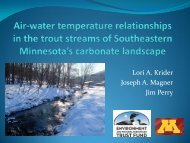Minnesota Water Resources Conference - Water Resources Center ...
Minnesota Water Resources Conference - Water Resources Center ...
Minnesota Water Resources Conference - Water Resources Center ...
Create successful ePaper yourself
Turn your PDF publications into a flip-book with our unique Google optimized e-Paper software.
BOOK OF ABSTRACTS<br />
Tuesday, Monday, October 27 23<br />
Concurrent Sessions II 1:15–2:45<br />
Track D: Stream Erosion, continued<br />
Spatial Analysis and Modeling of Stream Bank Erosion for Carver and Bevens Creeks, <strong>Minnesota</strong><br />
Steve Kloiber, Metropolitan Council, steve.kloiber@metc.state.mn.us<br />
Streambank erosion can be a major contributor to stream impairment due to excessive sediment or turbidity.<br />
To formulate effective management plans, more information on the spatial distribution of streambank erosion<br />
is usually needed. This paper describes an effort that utilizes remote sensing and geographic information<br />
system data to perform a rapid assessment of 134 kilometers of stream in the Carver Creek and Bevens Creek<br />
watersheds located in central <strong>Minnesota</strong>. LiDAR and high resolution digital aerial photography were used<br />
along with soils and land cover data to develop an erosion assessment. Lateral erosion rates were measured<br />
by comparing streambank locations for selected stream segments digitized from 2000 and 2005 digital aerial<br />
photographs. Lateral erosion rates were significantly correlated to four independent variables with an r 2 =<br />
0.68. The variables included in the model are mean bank slope, soil erodibility, specific catchment area, and<br />
sinuosity. The regression equation was then applied to the entire length of mapped streams to predict the spatial<br />
distribution of streambank erosion. Combining this information with bank height and soil bulk density, the<br />
estimated gross erosion mass from Bevens Carver Creeks is 65,000 metric tonnes/yr and 35,000 metric tonnes/<br />
yr, respectively. This information can then be used as an input in watershed sediment transport models or to<br />
help guide potential stream bank restoration efforts.<br />
29 <strong>Minnesota</strong> <strong>Water</strong> <strong>Resources</strong> <strong>Conference</strong>, October 27–28, 2008
















